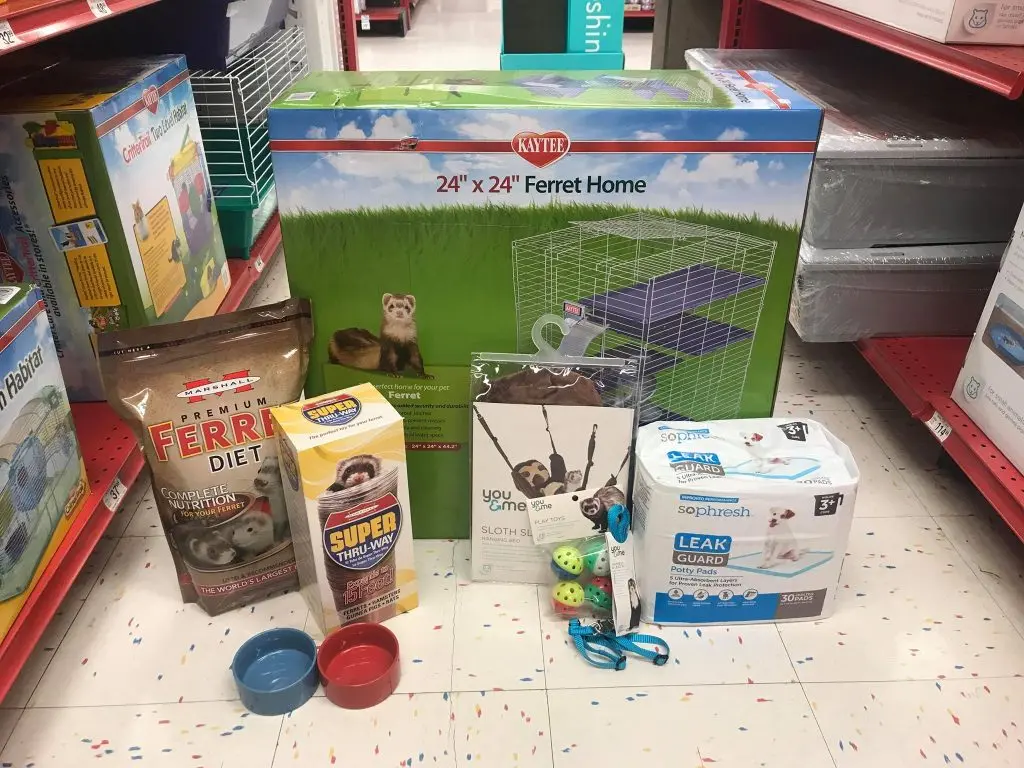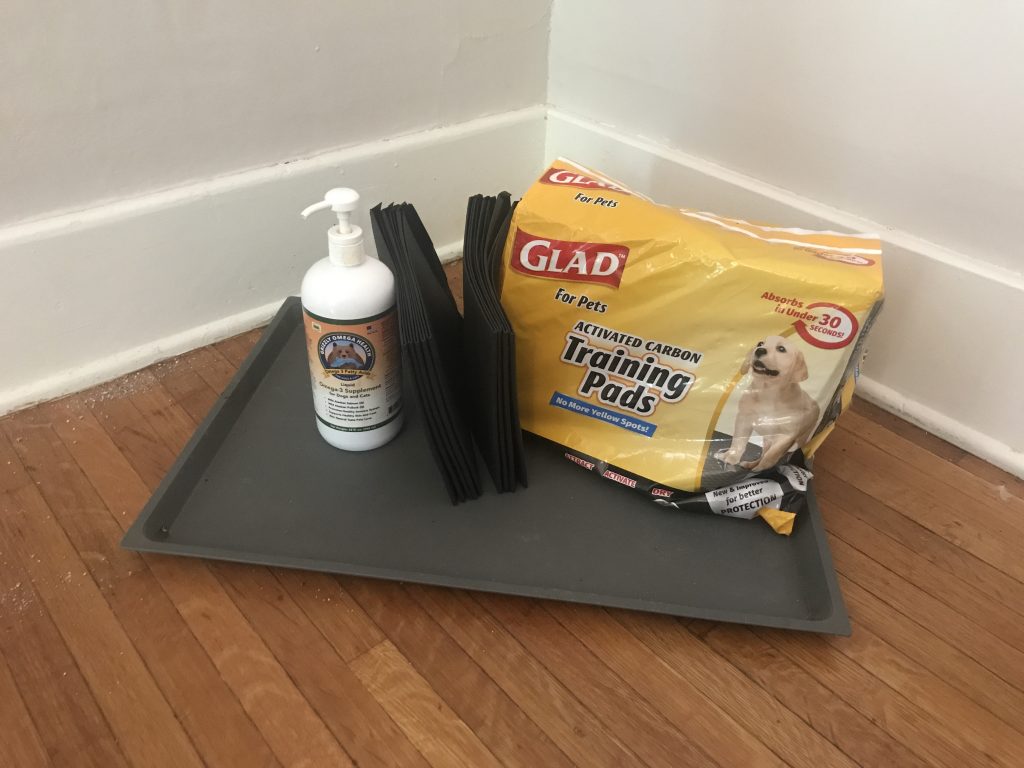Here is a detailed one-month step-by-step guide for new ferret owners and those of you still considering buying or adopting a new ferret. These tips will take you from Day 1 to Day 30, helping ensure a smooth transition into ferret ownership. Let’s get started!
Welcome to Ferrenthood!
In this article, we will cover new ferret owner topics such as:
- What to Buy at the Pet Store for Your Ferret
- What NOT to Buy at the Pet Store
- Buy These Items Online Instead of at Petco
- Transition Their Diet to a Healthier Food
- On the Car Ride Home
- Once You’re Home
- How to Ferret Proof Your Room
- How to Pick Up a Ferret/ How Not to
- Bite Training
- Potty Training
- How to Play/Bond with a New Ferret
- Your First Month with a New Ferret
- Your New Life with Ferrets
Ready to get started? Let’s go!
While You’re Still at the Pet Store:
Before you leave Petco (or another pet store) with your new ferret, it’s important to grab a few supplies that you will need immediately. Ideally, you should purchase these items before you bring your fuzzy home (at least one month beforehand). However, sometimes that is not possible. The list below may differ from what an employee at your pet store recommends so pay close attention to the information below. (If you are already home, all the items below can be ordered online as well):
Please note: some of these items are temporary placeholders until you can upgrade with a different product online and return your product to the pet store.
What to Buy at the Pet Store for Your Ferret

- Temporary Cage (return after you get a bigger cage online)
- Temporary Food until your healthier food arrives (make sure to ask what they are already eating -most likely Marshall Pet Ferret Food)
- Food and Water Dishes (heavy ceramic dishes)
- Extendable tunnels (in ferret section)
- Hammock (in ferret section)
- Rubber-free/foam-free/choke hazard-free toys (in ferret section)
- Harness and leash (optional, baby ferret may be too small)
- Potty Pads to line the bottom of the cage (in the dog section)
*ask pet store associate to let you put some used cage bedding from their current cage in a box to comfort your new ferret*
What NOT to Buy at Petco for Your Ferret

Unfortunately, the ferret section at your local pet store is often stocked with useless or dangerous items for your ferret. Here are some items we recommend you avoid:
- Ferret shampoos and sprays (unnecessary, proper diet and cleaning their cage reduces odor)
- Running ball (stressful for ferrets and can cause back issues)
- Rubber or plastic toys (ferrets WILL chew and ingest pieces, causing possible intestinal obstruction)
- High sugar treats like Ferretvite and FerretLax (any treat containing sugar, syrup, dextrose, is harmful to your ferret and may cause insulinoma)
- Small cage (ferrets need a minimum of 3 ft x 2 ft x 2 ft -according to Ferrets for Dummies)
- Water bottle (causes teeth damage, use water bowl instead)
- Running wheel (bad for your ferret’s back)
- Wood shavings (can cause breathing problems, use potty pads instead)
- Cheap ferret food (high in carbohydrates, may increase chance of health problems)
What to Buy Online Instead of at Petco
Here’s a list of items you can opt to buy online for your ferret. You can find the complete Amazon shopping cart (with even more items available) here.
Transition their Diet to a new Ferret Food
Most likely you purchased your baby ferret at Petco. If so, they came from a breeder called Marshall Pet Farms. As part of your ‘adoption contract’ when you bought your ferret, they require you to feed Marshall Food for one year, otherwise they refuse to be responsible if your ferret dies. Ironically enough, many experienced owners believe Marshall Food to be one of the unhealthiest kibble to feed your ferret.
When we polled the ferret community, one of the most common regrets was feeding an unhealthy food for far too long. Many feel this leads to health problems in the long run which can be costly and heart-breaking. If you would like to ensure the long-term health of your ferret, we strongly recommend upgrading your ferret’s food. If you have concerns about the recommendations on this site, we encourage you to reach out to other prominent pet groups on the internet and they will most likely tell you the same thing.
The top recommended ferret kibble at this time is Wysong and the best time to switch food is when ferrets are young and not as picky. Buy it here now to begin transitioning as soon as possible.
On the Car Ride Home
Now that you have your new pet and some basic supplies in hand, it is time to go home. If it is a particularly warm day, make sure to turn your car’s AC on to keep the temperature below 75 degrees. Avoid playing loud music or rolling down the windows. The goal is to minimize stress to your new pet as much as possible.
Once You’re Home
Once you’re home, take it slow. Resist the urge to take out your new pet, parade them around to family and pets, or let them run around the entire house. Instead, focus on creating a safe environment for your new ferret to rest.
While your ferret is still in their temporary carrier, build their cage. As discussed in the ‘supplies’ section above, you will be housing your ferret in a temporary Petco cage (until your Midwest Ferret Nation cage arrives and you can return it).
Next, set up their food and water area inside their cage. Set up a potty pad in the corner. Put a worn t-shirt or two in the corner of their cage for them to sleep in.
TIP: Ferrets prefer to sleep in dark, quiet places. Ideally, their cage should be in a place away from any major household chaos. Also, make sure to place your ferret’s cage away from any direct sunlight or drafty vents. As stated before, ferrets require a temperature under 75 degrees Fahrenheit to remain happy and comfortable (otherwise they can succumb to heat stroke which can be fatal).
Place your ferret in their new cage and let them rest, undisturbed, for 2-3 hours.
How to Ferret-Proof Your Room
While your new buddy is sleeping off all the excitement (and stress), it’s the perfect time to fix up your room.
For the first month or so, it is a good idea to restrict your ferret’s access to only a single, supervised room. That way you can minimize the risk of danger to your ferret (and your home).
Ferrets are professional escape artists. They can squeeze into anything their heads can fit into, so it’s important to look over any possible hazard in your ferret’s new room.
If you plan to house your new fuzzy in a bedroom, we recommend looking at beds, couches, vents, and gaps under doors -among other things- as potential risks.
Here’s a complete guide on how to ferret-proof your bedroom. Check it out and then proceed to the following steps:
Important Next Step
After you ferret-proof your room, take a moment to purchase any remaining items you still need online (especially new, healthier food and a bigger, safer cage). Also, do some research to find a vet with ferret experience in your local area. Call to set up an appointment for your little one to get their remaining rabies and distemper shots. This step should not be skipped.
Potty Training
After you’ve ferret-proofed the room and ordered all remaining supplies on your ferret care checklist, it’s time to check on your sleepy buddy. Ideally, 2-3 hours have passed by this time.
Go up to your ferret’s cage and gently say hello. If your ferret has just woken up, he will probably need to go to the bathroom within the next 15 minutes. This is your chance to establish a routine. Feel free to interact with him through the cage but wait to take him out of the cage until he poops.
Once he goes potty, reward your smart little baby by saying ‘good job!’ in a gentle voice.
For a much more in-depth article on how to potty train your ferret, check out our Ultimate Guide to Ferret Potty Training.
How to Pick Up a Ferret (And How Not to)
Now that your ferret has gone potty, it’s time to let him out of the cage to explore his new home (remember -only give access to a single room!). This is a great time to pick up your new pet and get them used to being held.
When picking up any pet, it is important to support their bodies. Grab your ferret by placing one hand under their chest. Use your other hand to support the weight of their bottom. Before picking up your ferret, you can place oil on your hand or arm for them to lick while you hold them.
TIP: Do not grab your ferret quickly. This can frighten your scared, new pet and encourage them to bite. Instead, pick them up in a calm, slow manner. Also, do not pick up your ferret by the tail as this can break it.
In the beginning, try picking them up and petting them for ~30 seconds, using a gentle voice with encouraging words. As a reward for allowing you to hold them, set your fuzzy down to explore after the 30 seconds is over.
Bite Training
It is common for baby ferrets to bite. This is not a reflection of ferrets in general as aggressive animals. Rather, think of your ferret like a puppy. Puppies mouth and teeth to explore and communicate. Ferrets are the same in this way.
Here are a couple reasons why your baby ferret bites:
- Baby teeth
- They are still learning ‘bite inhibition’
Just like a puppy, your baby fuzzy is going through a lot of changes. For one, they may be losing their baby teeth and growing in their shiny new adult teeth. This can cause your ferret to be extra nibbly!
Another reason your fuzzy may bite is they need you to teach them ‘bite inhibition’. This is when a baby ferret’s mom and siblings teach each other how hard is too hard when it comes to biting. Ferrets have much thicker skin than humans, so you need to teach your ferret how rough is too rough when it comes to playing with you (rather than their fellow ferrets).
Ferrets are very perceptive and intelligent, so with consistent repetition they will learn what you want. For baby ferrets, we recommend playing with them as much as possible. Each interaction is an opportunity to teach your ferret bite inhibition. You can also try placing oil on your hand each time you interact with them, to encourage them to lick before they think to bite.
TIP: If your ferret mouths you lightly and it doesn’t bother you, there is no reason to un-train this behavior.
For a more in-depth answer, check out our step-by-step guide on how to bite train your new ferret.
Most importantly, do NOT give up on your new pet if they bite you. Do not become scared of your nippy little guy and lock him away in their cage all day as punishment. You need to be patient and train this behavior out of them. Bonding is key when it comes to raising a well-behaved ferret.
How to Play/Bond with a New Ferret
“How your ferret interacts with you is molded early, so the first 24 hours are critical.” – Erika Matulich, Ph.D. wrote in Ferrets USA
Here is an example schedule for the first 24 hours with your new ferret:
- 2:00 PM: get ferret from pet store, buy in-store supplies
- 3:00 PM: get home, put them in carrier with blanket, set up cage, let them settle/rest/sleep in for 2 hours, ferret proof your room, buy online supplies, find a vet online and make appt.
- 7:00 PM: wake up ferret, let him go potty in the cage, put oil on hand, hold him briefly while he licks you, let him explore room for 30 minutes while you sit on the floor and let him climb on you and sniff you, put him back in the cage for the rest of the night, check food and water are full before night time, change potty pads
- 8:00 AM: wake up ferret, let him go potty in the cage, put oil on hand, hold him briefly while he licks you, let him explore room for 30 minutes while you sit on the floor and let him climb on you and sniff you, practice bite training, put back in cage, refill food –perhaps you eat your own breakfast sitting on the floor while your fuzzy explores his new owner and his new home
- 11:00 AM: wake up ferret, let him go potty, put oil on hand and hold him, let him explore the room for 1 hour while you hangout with him (on your phone sitting on the floor if you’d like), practice bite training, return him to his cage
- 2:00 PM: wake up ferret, let him go potty, put oil on hand and hold him, let him explore room for 1 hour while you hangout with him (on your phone sitting on the floor), practice bite training, return him to cage after
The routine above will teach your ferret the following:
- “My safe place to sleep is in my cage”
- “I know I will get to play outside of my cage every day, so I am not bored or stressed”
- “I go potty in my cage before I get to play”
- “My new owner feeds me, pets me, and gives me treats”
- “I get a treat when my new owner holds me so I like being held now!”
- “My new owner (who looked big and scary at first!) will not hurt me when we play in my room”
- “My new owner does not like to be bit as hard as my brothers did, so I need to be gentle if I want to play”
TIP: After the first 24 hours, you can begin to introduce your ferret to other members of your family. Do it slowly, one at a time, and under supervision. Be extremely cautious around small children and pets.
Your First Month with a New Ferret
After the first couple days at home with your new pet, it’s important to establish a routine. Here are some parts of your routine to keep in mind:
- check daily and refill food and water regularly
- clean your ferret’s litter box daily (this will prevent potty accidents)
- clean your ferret’s cage weekly
- let them free-play in their room every day
- practice bite training with them
- play with them
- hold them daily (to encourage cuddling behavior)
- ensure your ferret spends a minimum of 4 hours per day outside of their cage
Your New Life with Ferrets
Ferrets are incredible pets for the right person. Just like dogs, ferrets require a lot of love and attention. They are incredibly emotional, intelligent creatures that crave a deep meaningful bond with their owners. Step one is getting the right supplies -the entire list can be found here. Step two is getting your home ready. But step 3 is putting in the work to turn your ferret into the pet of your dreams (and you into the owner of your ferret’s dreams!). We hope you found this guide helpful, and we encourage you to leave a comment below with any (seriously ANY!) questions you may have, so we can help more new ferret owners like you.
Next Up…
Every new ferret owner needs to brush up on the basics about ferrets (a lot of this you wont learn at the pet store!). Check out our suggested reading: Everything You Need to Know About Ferrets.




